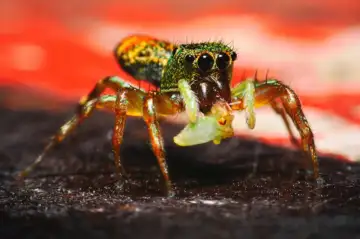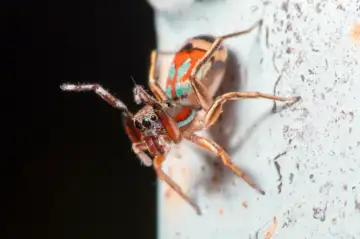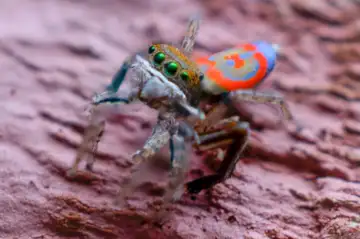The unusual DNA of a particular type of spider is fascinating scientists, as they think it may hold the key to diverse evolution across the world we live in.
Australia’s peacock spider, known for its dance moves and vibrant colours, has evolved into 100 different species while most animals only have five or ten.
Scientists are trying to uncover the puzzling reason why there are so many variations in its species by closely studying the arachnid’s ‘dark DNA’ – an enigma in its genetic material.
 Researchers propose that the dark DNA might be the cause of the spider’s ability to quickly adapt to environments and form new species.
Researchers propose that the dark DNA might be the cause of the spider’s ability to quickly adapt to environments and form new species.
Male peacock spiders can be identified by the spectacular multicoloured design they have on their abdomen resembling a peacock’s feathers, hence the appropriate name, which they use to attract a mate.
These pinhead-sized creatures can bust out a song and dance, creating a rhythmic drumming sound with their feet, while performing in their patterned costume of colours.
Jonah Walker, of the Sanger Institute, travelled to Australia for his PhD to study the science behind the development of their numerous species, despite admitting his previous fear of spiders.
“When I told friends and family that I was going to study spiders in Australia I got some worried looks and I was obviously apprehensive myself. But just a few seconds of watching them dance was enough for any fears to be washed away,” he told BBC News.
 Alongside his group leader, Dr Joana Meier, and an international team, Mr Walker has collected a sample of all the known discovered species of the spider and meticulously categorised them in regard to their behaviour, movement and songs.
Alongside his group leader, Dr Joana Meier, and an international team, Mr Walker has collected a sample of all the known discovered species of the spider and meticulously categorised them in regard to their behaviour, movement and songs.
The research was then cross-referenced with the DNA of each species, which, when compared, could reveal which genes correspond to which trait and explain why there is an abundance of peacock spider variations.
Although the research is still in its earliest stages, the team is optimistic that they already have a strong cause to investigate further.
A DNA strand is composed of a long string of molecules – parts of this are genes, which encode specific features and characteristics, such as eye colour or height for humans.
 Yet the majority of sections of DNA are not genes, and there is not enough information uncovered about what these parts are responsible for.
Yet the majority of sections of DNA are not genes, and there is not enough information uncovered about what these parts are responsible for.
It is these ‘dark DNA’ sections which researchers at the Sanger Institute believe may be accountable for the diverse range of peacock spiders. They have triple the amount of ‘dark DNA’ that humans have.
Researchers of the Earth BioGenome Project have successfully deciphered the DNA of 3,000 different species so far.
Next year they aim to decode 10,000, and in 10 years’ time they want to complete all 1.8 million living species, in the hope it will shed light on how all living things evolve and relate to one another.
